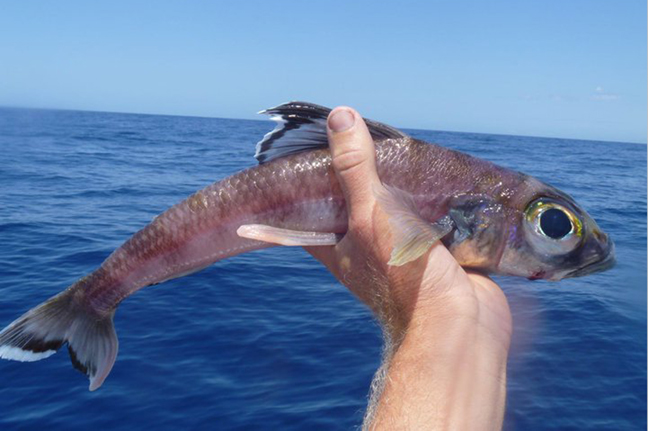Banded Cucumberfish, Paraulopus balteatus Gomon 2010

A Banded Cucumberfish, Paraulopus balteatus, caught on a dropline at Browns Seamount, southeast of Botany Bay, New South Wales. Source: Brenden Kong. License: All rights reserved
Banded Cucumberfish, Paraulopus balteatus Gomon 2010
More Info
|
Distribution |
Off New South Wales between 30-35°S, and seamounts and rises in the Tasman Sea including off Lord Howe Island. Elsewhere the species occurs in the Tasman Sea north of New Zealand: the Three Kings Ridge just north of the northern boundary of New Zealand’s EEZ. Greeneyes inhabit deep water on the continental slope, resting up off the bottom on their thickened pelvic-fin rays. |
|
Features |
Dorsal fin 11; Anal fin 9; Caudal fin 1+8+1+9+8+1+8+1; Pectoral fin 19; Pelvic fin 9; Vertebrae 19+29; Lateral line scales 48–49; scales above lateral line 5.5; scales below lateral line 3.5; predorsal scales 19–24; Gill rakers 8–9 + 18–20 = 27–28. |
|
Size |
Largest known specimen: 32 cm SL |
|
Colour |
Body dusky above, pale below, with two broad brown bands around body and a third at tail base, and several broad diagonal blotches between bands. Snout, dorsal part of cheek and operculum very dark. Buccal lining of mouth black; tongue black with white tip and lateral margins. Dorsal fin dark brown basally with broad black marginal stripe occupying distal half (to third) of fin anteriorly, and broad white submarginal stripe. Adipose fin dusky. Anal fin white with a narrow black margin anteriorly and distally in males; entirely white in females. Caudal fin dark basally with broad pale vertical intermediate band and a narrow white marginal band with a black submarginal band on the upper lobe and a narrow black marginal band on the dorsal two-thirds of the lower lobe. Pectoral fin dusky. Pelvic fin rather dark with white margin on distal edge and distally along anterior edge; fine black distal edge (in males only). |
|
Biology |
Almost nothing is known of the biology of this species. The sexes are separate and fertilisation is external. |
|
Fisheries |
Occasionally taken as by-catch in trawl fisheries, and also deep water drop lines by recreational anglers. |
|
Conservation |
|
|
Remarks |
|
|
Similar Species |
Similar to Paraulopus okamurai, a closely related species that occurs in the same area. P. balteatus reaches a similarly large size and also has distinctive black-and-white-patterned dorsal and caudal fins. P. balteatus has prominent broad dark bands on the sides of adults (versus, at most, much smaller brown blotches midlaterally and a smaller brownish saddle behind the adipose fin in P. okamurai), 8–9 anal fin rays (versus 9–11 rays, rarely 9), 19 pectoral fin rays (versus 16–17), and an entirely black interior of the mouth, except for the tongue, which has white at the tip and along the lateral edges (versus entirely pale in P. okamurai) |
|
Etymology |
The specific name is from the Latin balteatus (= belted, banded), in reference to the distinctive broad brown bands on the sides of the body in this species. |
|
Species Citation |
|
|
Author |
Gomon, M.F. & Bray, D.J. 2020 |
|
Resources |



